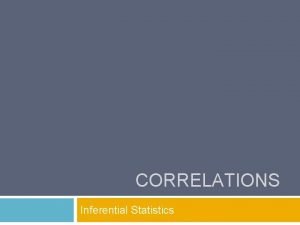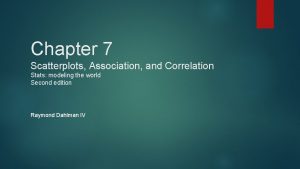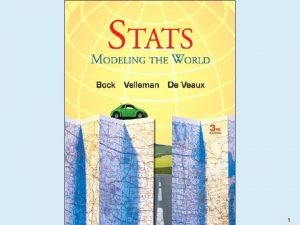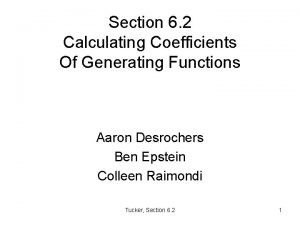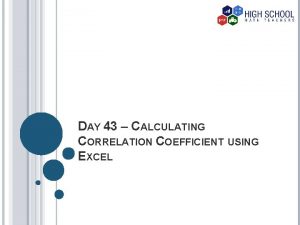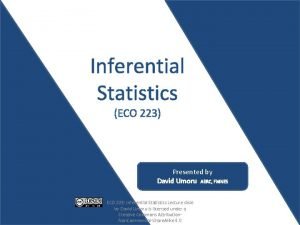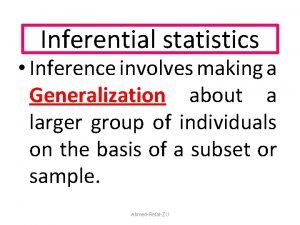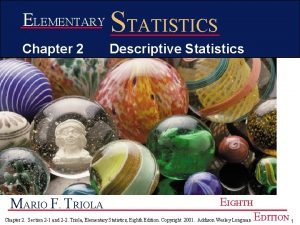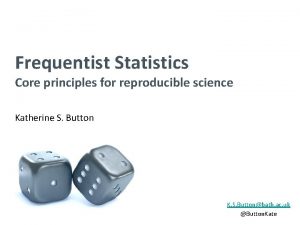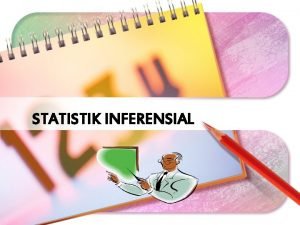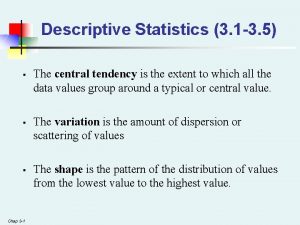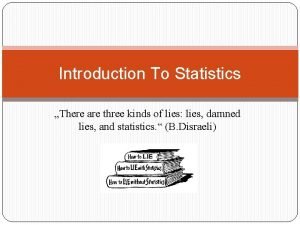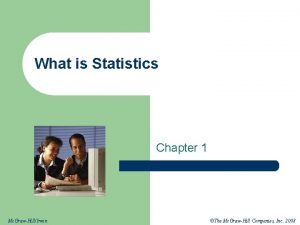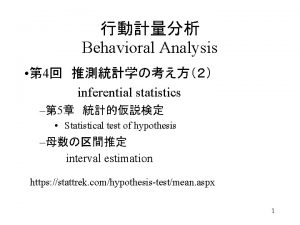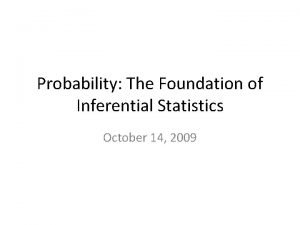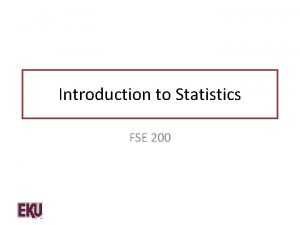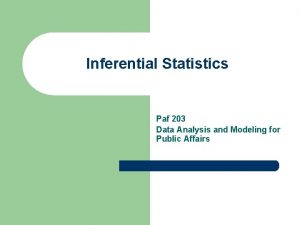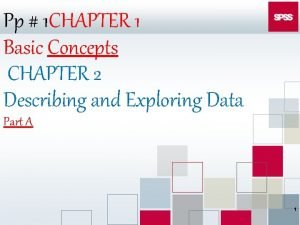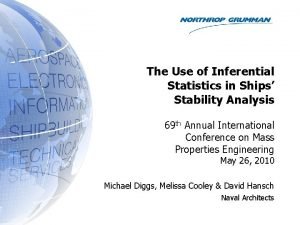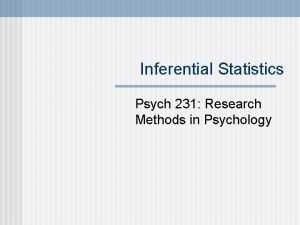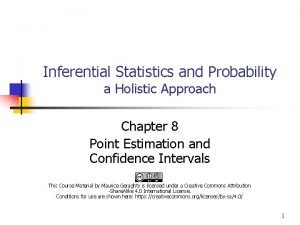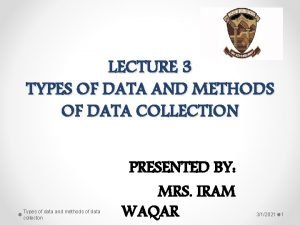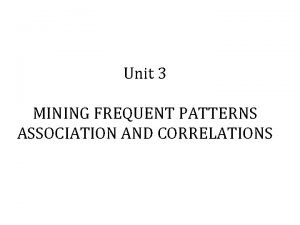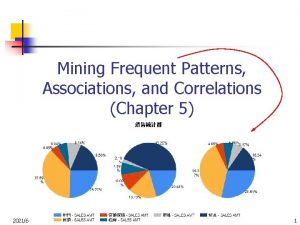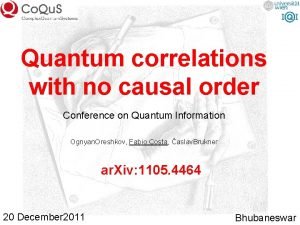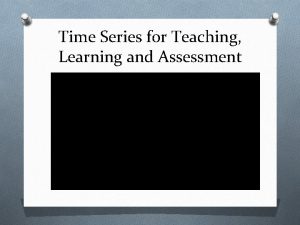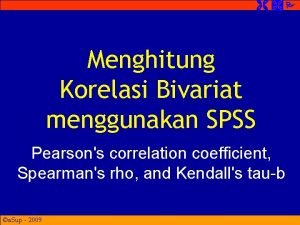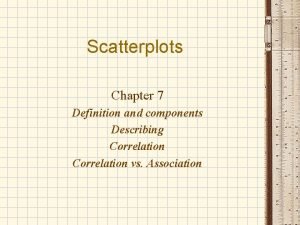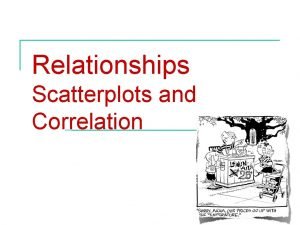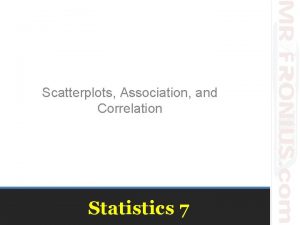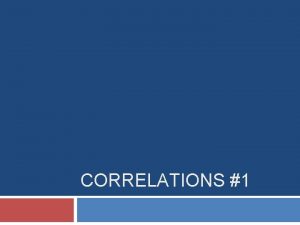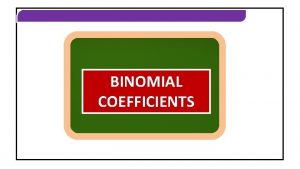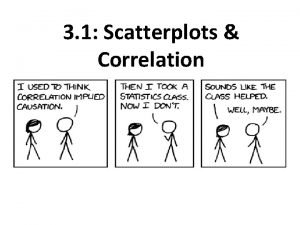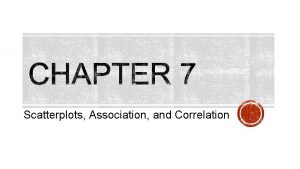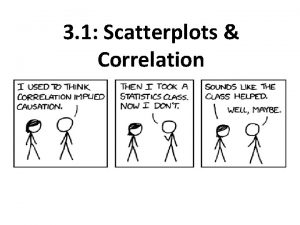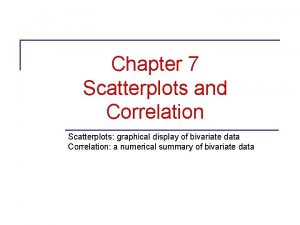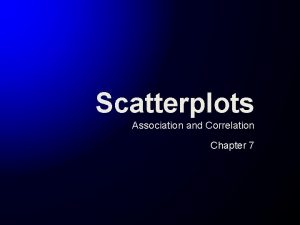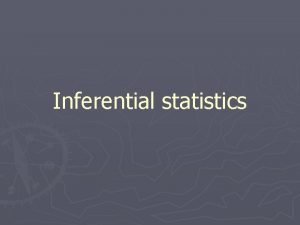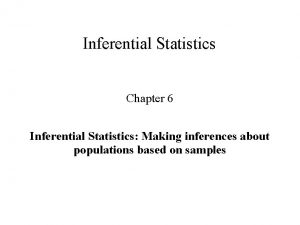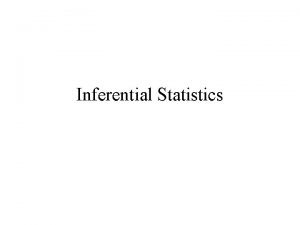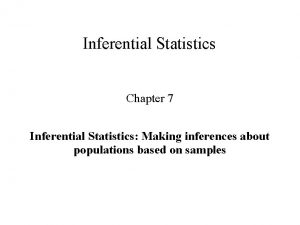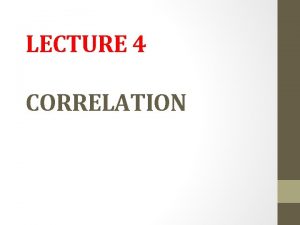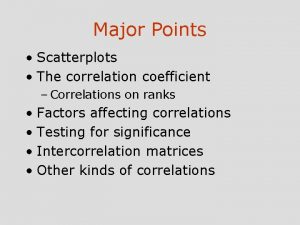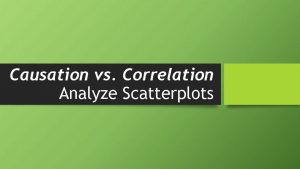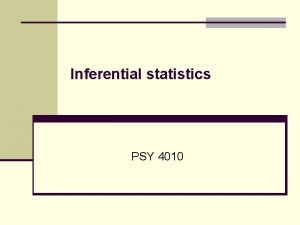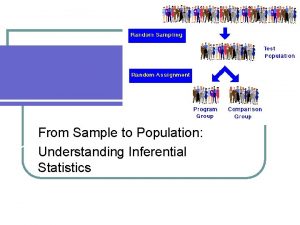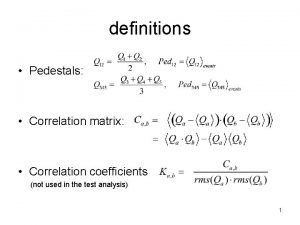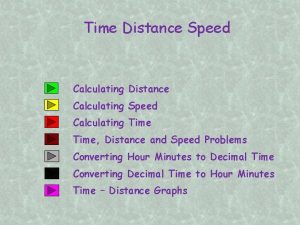CORRELATIONS Inferential Statistics Overview Correlation coefficients Scatterplots Calculating



































- Slides: 35

CORRELATIONS Inferential Statistics

Overview Correlation coefficients Scatterplots Calculating Pearson’s r Interpreting correlation coefficients Calculating & interpreting coefficient of determination Determining statistical significance Calculating Spearman’s correlation coefficient

Correlation Reflects the degree of relation between variables � Calculation of correlation coefficient Direction + (positive) or – (negative) Strength (i. e. , magnitude) Further away from zero, the stronger the relation � Form of the relationship

Check yourself Indicate whether the following statements suggest a positive or negative relationship: � High school students with lower IQs have lower GPAs � More densely populated areas have higher crime rates � Heavier automobiles yield poorer gas mileage � More anxious people willingly spend more time performing a simple repetitive task

Scatterplots

Correlation & Scatterplots Exam 1 X Exam 2 Y Participant 1 100 95 Participant 2 60 65 Participant 3 75 80 Participant 4 80 85 Participant 65 60 Benefits of scatterplot 5 • Form of relation Participant 60 outliers? 70 • Any possible 6 • Rough guess of r Participant 85 80 7 r =. 91

Correlation & Scatterplots Number of Arrests X GPA Y Participant 1 0 4. 0 Participant 2 5 3. 7 Participant 3 10 2. 8 Participant 4 20 2. 5 Participant 5 30 1. 0

Correlation & Scatterplots Number of Arrests X GPA Y Participant 1 0 4. 0 Participant 2 5 3. 7 Participant 3 10 2. 8 Participant 4 20 2. 5 Participant 5 30 1. 0 # of times arrested

Pearson’s r Formula SP = Sum of products (of deviations) SSx = Sum of Squares of X SSy = Sum of Squares of Y

Pearson’s r Calculating SP � Definitional 1. formula 2. 3. � Computational formula Find X & Y deviations for each individual Find product of deviations for each individual Sum the products

Example #1 Calculating SP – Definitional Formula Step 2: Multiply the deviations from the mean X Y X-MX Y-MY 2 2 2 -3 = -1 2 -4 = -2 (X-MX)(YMY) 2 4 2 -3 = -1 4 -4 = 0 (-1)(-2) = 2 3 3 3 -3 = 0 3 -4 = -1 (-1)(0) = 0 5 7 5 -3 = 2 7 -4 = 3 (0)(-1) = 0 (2)(3) = 6 SX = 12 SY = 16 MX = SX/n = 12/4 = 3 MY = SY/n = 16/4 = 4 Step 1: Find deviations for X and Y separately Step 3: Sum the products

Example #1 Calculating SP – Computational Formula X Y XY 2 2 4 8 3 3 9 5 7 35 SX = 12 SY = 16 MX = SX/n = 12/4 = 3 MY = SY/n = 16/4 = 4

Calculating Pearson’s r 1. Calculate SP 2. Calculate SS for X 3. Calculate SS for Y 4. Plug numbers into formula

Calculating Pearson’s r 1. Calculate SP 2. Calculate SS for X 3. Calculate SS for Y 4. Plug numbers into formula X Y 2 2 2 4 3 3 5 7

Example #1 - Answers Calculating Pearson’s r X Y X-MX Y-MY XY X 2 Y 2 2 -4 = -2 (X-MX)(YMY) 2 2 2 -3 = -1 4 4 4 2 -3 = -1 4 -4 = 0 (-1)(-2) = 2 8 4 16 1 4 3 3 3 -3 = 0 3 -4 = -1 (-1)(0) = 0 9 9 9 1 0 5 7 5 -3 = 2 7 -4 = 3 (0)(-1) = 0 35 25 49 0 1 4 9 SX = 12 SY = 16 MX = SX/n = 12/4 = 3 MY = SY/n = 16/4 = 4 (2)(3) = 6 (X-MX)2 (YMY)2

Pearson’s r r = covariability of X and Y separately

Using Pearson’s r Prediction Validity Reliability

Verbal Descriptions 1) r = -. 84 between total mileage & auto resale value 2) r = -. 35 between the number of days absent from school & performance on a math test 3) r = -. 05 between height & IQ 4) r =. 03 between anxiety level & college GPA 5) r =. 56 between age of schoolchildren & reading comprehension level

Interpreting correlations Describe a relationship between 2 vars � Correlation does not equal causation Directionality Problem Third-variable Problem Restricted range � Obscures relationship

Interpreting correlations Outliers � Can have BIG impact on correlation coefficient

Interpreting correlations Strength & Prediction � Coefficient of determination r 2 Proportion of variability in one variable that can be determined from the relationship w/ the other variable �r =. 60, then r 2 =. 36 or 36% � 36% of the total variability in X is consistently associated with variability in Y � “predicted” and “accounted for” variability

Mini-Review Correlations � Calculation Sum � Using of Pearson’s r of product deviations Pearson’s r � Verbal descriptions � Interpretation of Pearson’s r

Example #2 Practice – Calculate Pearson’s r 1. Calculate SP 2. Calculate SS for X 3. 4. Calculate SS for Y Plug numbers into formula Ex 1 X Y 2 9 1 10 3 6 0 8 4 2

Example #2 X Y X-MX Y-MY 2 9 2 -2 = 0 1 10 3 SP = S(X-MX)(YMY) SS Y XY X 2 Y 2 9 -7 = 2 (X-MX)(YMY) 18 4 81 1 -2 = -1 10 -7 = 3 (0)(2) = 0 10 1 100 0 4 6 3 -2 = 1 6 -7 = -1 (-1)(3) = -3 18 9 36 1 9 0 8 0 -2 = -2 8 -7 = 1 (1)(-1) = -1 0 0 64 1 1 4 2 4 -2 = 2 2 -7 = -5 (-2)(1) = -2 8 16 4 4 1 4 25 (2)(-5) = -10 SX = 10 SY = 35 MX = SX/n = 10/5 = 2 MY = SY/n = 35/5 = 7 (X-MX)2 SS X (YMY)2

Hypothesis Testing Making inferences based on sample information Is it a statistically significant relationship? Or simply chance?

Conceptually - Degrees of freedom Knowing M (the mean) restricts variability in sample Score � 1 score will be dependent on others n = 5, SX = 20 If we know first 3 scores If we know first 4 scores X 1 = 6 X 2 = 4 X 3 = 2 X 4 = 5 X 5 = 3 Σx = 20 With n=5, there can be only 4 df

Correlations – Degrees of freedom There are no degrees of freedom when our sample size is 2. When there are only two points on a scatterplot, they will fit perfectly on a straight line. 6 Depression 5 4 3 2 1 0 0 0. 5 1 1. 5 2 2. 5 Anxiety Thus, for correlations df = n – 2

Using table to determine significance Find degrees of freedom � Correlations: df = n – 2 Use level of significance (e. g. , a =. 05) for twotailed test to find column in Table Determine critical value � Value calculated r must equal or exceed to be significant Compare calculated r w/ critical value � If calculated r less than critical value = not significant APA � The correlation between hours watching television and amount of aggression is not significant, r (3) = -. 80, p >. 05. Think about sample size

Spearman correlation Used when: � Ordinal data If 1 variable is on ratio scale, then change scores for that variable into ranks Difference between pair of ranks

Example #3: Spearman correlation 1 st race 2 nd race 4 3 1 2 9 8 8 6 3 5 5 4 6 7 2 1 7 9

Example #3: Spearman Answers 1 st race 2 nd race D D 2 1 1 4 3 -1 1 1 2 1 1 9 8 2 4 8 6 -2 4 3 5 1 1 5 4 -1 1 6 7 1 1 2 1 -2 4 7 9

Example #4: Spearman Correlation Two movie raters each watched the same six movies. Is there are relationship between the raters’ rankings? Example Rater 1 1 Rater 2 6 2 4 3 5 2 6 1

Example #4: Spearman answers Rater 1 Rater 2 D D 2 -5 25 1 6 -2 4 3 5 1 1 4 3 3 9 5 25 6 1

Pearson r (from SPSS) Spearman rs (from SPSS)

Example #5: Pearson’s r 35 Participant (Y) 1 2 3 4 1. 2. 3. 4. Motivation (X) 3 6 9 2 Depression 8 4 2 2 Sketch a scatterplot. Calculate the correlation coefficient. Determine if it is statistically significant at the. 05 level for a 2 -tailed test. Write an APA format conclusion.
 Inferential statistics correlation
Inferential statistics correlation Chapter 7 scatterplots association and correlation
Chapter 7 scatterplots association and correlation Chapter 7 scatterplots association and correlation
Chapter 7 scatterplots association and correlation Generating functions
Generating functions Intraclass correlation coefficient excel
Intraclass correlation coefficient excel Inferential statement of the problem example
Inferential statement of the problem example Standard deviation in psychology
Standard deviation in psychology Inferential generalization
Inferential generalization What are class limits in statistics
What are class limits in statistics Inferential statistics
Inferential statistics Uji t
Uji t Define inferential statistics
Define inferential statistics Dichotomic and polynomic
Dichotomic and polynomic Hypothesis setting
Hypothesis setting Descriptive statistics definition
Descriptive statistics definition Inferential statistics 意味
Inferential statistics 意味 Does qualitative research have hypothesis
Does qualitative research have hypothesis Empirical method probability
Empirical method probability Characteristics of inferential statistics
Characteristics of inferential statistics Rare event rule for inferential statistics
Rare event rule for inferential statistics Inferential statistics examples
Inferential statistics examples Characteristics of inferential statistics
Characteristics of inferential statistics Advantages of inferential statistics
Advantages of inferential statistics Inferential statistics
Inferential statistics Characteristics of inferential statistics
Characteristics of inferential statistics Data collecton
Data collecton Positive and negative correlation
Positive and negative correlation Positive correlation versus negative correlation
Positive correlation versus negative correlation Mining frequent patterns associations and correlations
Mining frequent patterns associations and correlations Mining frequent patterns associations and correlations
Mining frequent patterns associations and correlations Mining frequent patterns associations and correlations
Mining frequent patterns associations and correlations Quantum correlations with no causal order
Quantum correlations with no causal order Spurious correlations
Spurious correlations Korelasi bivariat
Korelasi bivariat Thinking critically
Thinking critically Describing scatterplots
Describing scatterplots
